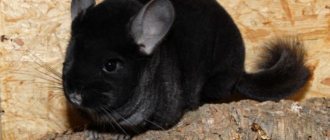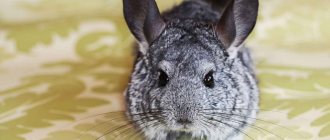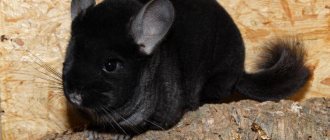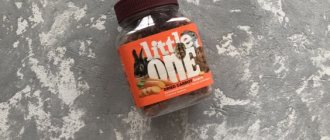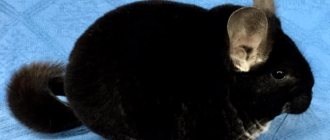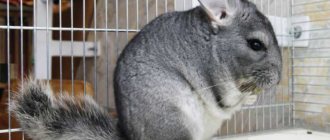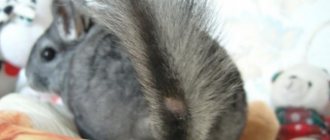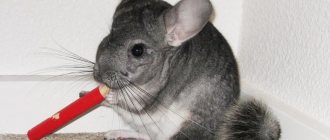- home
- Chinchilla
- Health
03/22/2019 Chinchillas are pets that are quite difficult to control. They are willful, self-sufficient and smart. They are usually quite active and constantly on the move. Therefore, when the owner notices that the chinchilla is lying on its side, it is worthwhile to figure out what is the reason for this behavior of the animal. This could be a sign of serious health problems.
When to worry about a chinchilla lying on its side
If you do not take good care of your pet and feed it inappropriate, low-quality food, then it may contract an infection or get sick, despite its fairly good health.
In case of illness or poor health, you urgently need to contact a veterinary clinic for examination, obtaining the necessary help and prescribing treatment for your pet.
Stroke
It occurs more often in adults - with regular stress, injury to the animal, or intoxication.
- the animal is unsociable, lies on its side with heavy breathing;
- the animal has lost its appetite and does not eat;
- the pet can actively drink water;
- becomes aggressive.
Brain pathologies
If damage to the cerebellum occurs as a result of injury or compression by the resulting tumor, the animal will behave differently:
- when moving, it falls to one side;
- lying on his side, stretches his limbs;
- does not take food;
- the pet's face may become deformed;
- squint appears
- the animal is sick.
Epilepsy
This disease can be present from birth or acquired during life. The attacks occur at different intervals and strength, during which the pet falls on its side, its body wriggles and convulses.
Heatstroke
A chinchilla should not be kept in a room where the temperature exceeds 25 degrees Celsius. This is very dangerous for them and threatens death.
Lack of B vitamins and calcium
It manifests itself in the animal falling to one side and convulsions.
In such a situation, there is no need to hope for the best; the animal urgently needs help; leaving it unattended or trying to help yourself at home can be deadly for your pet.
What I am a master at is talking incessantly about hamsters. I have three hamsters at home, and my husband has a pet rat. That’s how we live, the six of us eat, the six of us sleep :)
Slobber
Drool is a dental disease.
Chinchillas come in two varieties
such a disease:
- when the animal has sharp edges of its molars;
- improperly grown incisors.
The cause of the disease
Usually it is an incorrect jaw structure. Over time, the sharp edges of the teeth begin to injure the inner cavity of the mouth, and salivation increases - saliva flows down the corners of the mouth.
Both pathologies are usually detected in the third year of life of animals, and can be inherited.
- If the disease is advanced
, the animal always has a wet neck, chest and front paws. The same symptoms appear when the incisors grow incorrectly.As a result, the animal’s mouth may not close at all, and the teeth will injure the gums.
- To avoid this, you need to cut off the sharp edges of the molars with a drill
, break them off and grind them with a tool. The operation is performed only under anesthesia. This can extend the animal's life by six months. Afterwards the edges will grow again. - If the growth of the incisors is impaired
, they can be trimmed with pliers. But this will only save the animal for a few months. The teeth will no longer grow normally, and it is likely that the animal will die from exhaustion.
Causes of low heart rate
Despite the fact that the maximum frequency indicators can be called conditional and individual, depending on a number of factors (undoubtedly, within certain limits), the pulse is below 50 beats/min. - a sign of the presence of a disease. Its reduction to forty beats poses a threat to health and life, since the brain suffers from oxygen starvation. If it does not exceed forty beats within seven days, this is a sign of bradycardia, and with a progressive decrease, you should urgently seek professional medical help.
Almost all initiating factors of a pulse below normal are related to pathological conditions. For convenience, experts divide them into different categories, which can be found in our table.
Category of causes What is it manifested by?
Physiological
There are a number of natural factors and external influences that initiate a low pulse at normal pressure. Such conditions are not dangerous. This:
Night sleep - when a person sleeps, all processes in his body slow down, including heart rhythms and blood circulation. At the same time, if the air in the room is stale, too cold or hot, the heart rate may drop critically; Air temperature: the lower it is, the lower the heart rate. This phenomenon is due to the body’s protective processes, they are not related to hypothermia or frostbite; Hormonal changes during adolescence. In the period from 12 to 17 years, the pulse rate can range from 30 to 200 beats. This happens due to a “shake-up” during the period of restructuring of the body, its maturation; Professional sports. Many athletes have such a well-pumped heart muscle, and the heart itself has an increased volume, that the prerequisites are created for the development of the so-called “athletic heart syndrome,” in which the heart rate does not exceed 50 beats/min.
It is worth saying that this phenomenon is not very beneficial for health due to oxygen starvation of the brain, as well as a high risk of malignant heart tumors and heart attacks.
Cardiological
The reasons for low blood pressure and low pulse may lie in the weakness of such a vital organ as the heart. They occur in the following diseases:
Decreased local blood supply - ischemia; Ischemic necrosis of myocardial tissue due to lack of blood supply - myocardial infarction; Heart failure syndrome due to decompensated myocardial dysfunction; Primary damage to the heart muscle of a non-inflammatory nature due to dystrophic and sclerotic processes in the heart cells is cardiomyopathy; Inflammatory processes of the cardiac muscle membrane of an infectious, allergic or rheumatic nature - myocarditis; Congenital and acquired heart defects due to anatomical features, scar formation, pumping function failures.
Toxicological
Low blood pressure and low pulse can develop due to interaction with toxic substances when:
Acute intoxication with poisons at work, consumption of food containing them, radiation therapy; Self-medication with taking pharmacological drugs not prescribed by a doctor; Deficiency or excess of potassium, sodium, magnesium in the body due to taking vitamin complexes that are not suitable in a particular case; Following diets that do not include carbohydrates, proteins, and vitamins important for the body; Alcohol abuse, tobacco smoking, drug use.
Associated pathological conditions
A complex of functional disorders due to failures in the regulation of vascular tone of the ANS - vegetative-vascular dystonia; Malfunctions of the endocrine system - diseases of the thyroid gland, adrenal glands, diabetes mellitus; A decrease in the level of red blood cells and hemoglobin in the blood - anemia; Respiratory diseases, characterized by narrowing of the trachea due to inflammatory processes; Severe diseases of infectious etiology, characterized by blocking of receptors that control the functioning of the aorta and valves; Swelling, hemorrhages, neoplasms of benign and malignant etiology in the cranial cavity.
Low heart rate in the elderly is associated with age-related changes in the body. It often develops due to concomitant diseases or a natural slowdown in the body’s metabolic processes.
Disadvantages of keeping chinchillas at home
- Chinchillas are nocturnal animals, so you should be prepared for night noises in the cage; you should not place it in the bedroom. When getting this rodent, you should be prepared to hear rustling, eating food, jumping and funny games every night.
- Despite the fact that the cage for such an animal should not be too large, it should also not be too small, especially in terms of height, it should have shelves on which the chinchilla could crawl and jump.
- Rodents also take sand baths; they cannot be prohibited from doing this, because such a procedure is necessary for them and is strictly prohibited. Therefore, you will have to clean the area next to the cage; scattered sand will often be found everywhere. Also, at least once a day you will still have to take care of your pet, that is, provide new hay and food, as well as pour fresh water.
- If you decide to let the rodent out for a walk around the apartment, you will need to monitor it very carefully. The point is that chinchillas can eat your furniture, wires, and also get into a place from which you will have to rescue the animal. The owner can turn away literally for a second, and the animal will already find itself in an unpleasant situation.
- It is extremely undesirable for these animals to endure stressful situations, and such for them can be an ordinary loud sound or a sudden movement in front of the cage during the day. Also, not all animals like to be cuddled, so it is not a fact that you will be able to play with your pet every day, but if you pick it up forcibly, this can negatively affect the health of the animal. Also, chinchillas need to be provided with optimal temperature conditions, they do not like heat, the maximum temperature for their life is +26 degrees, but if the temperature in your apartment is higher, then you will have to cool it with an air conditioner.
So, being at home has its positive and negative aspects.
The sounds they make
When communicating with children, a chinchilla may make a sound similar to whining. She may also whine when she is bored or when someone of the opposite sex is nearby. When a pet whines, but does it less often and sharply, it means that he is looking for something or asking, for example, to open the cage, give him food, or if the cub is lost.
If a chinchilla is interested in something, it will squeak easily and quickly. She makes this sound especially often when she runs around the apartment and new premises, since there is a lot of interesting things around. When a male shows interest in a female, he begins to grunt frequently, thereby indicating this. He also begins to beat his tail, trying to attract attention. In response, the female may react aggressively; she will begin to quack loudly and sharply, and if the male does not stop pestering her, she may even bite him. At this moment it is better to monitor their behavior.
Ringworm and fungus
Sometimes hair falls out on the body of chinchillas, this is very noticeable and greatly spoils the appearance of the animal. To understand that chinchilla lichen does not require any list of symptoms, it is already very noticeable.
Causes of deprivation:
- For stress or fear
- Weak immunity
- High humidity in the room
- Lack of vitamins
- Unsanitary conditions
- Contact with infected individuals
How does lichen (fungus) manifest?
- Skin lesions in specific areas
- Partial or complete absence of fur on the affected areas
- Dry skin, flaking in places
- In affected areas, the skin turns into a dense crust
- Occasionally purulent discharge appears, but this occurs most often due to advanced disease
We have collected for you several instructions on how to treat lichen at home in this article. Naturally, it is best to contact a veterinarian so that he examines the animal and decides whether treatment with folk remedies is suitable for him or whether it is necessary to urgently give the animal medication.
Hypothermia and colds
Thick and dense fur perfectly protects from the cold, but the absence of sweat and sebaceous glands leads to the fact that wet fur immediately loses its properties. If your pet gets wet, you should immediately wrap it in a soft towel and place it in a warm place until it dries completely.
We must remember that your pet is extremely sensitive to hypothermia and drafts. A cold for these animals often ends in death, since bronchitis and bronchopneumonia develop very quickly against the background of hypothermia.
At the first signs of a cold (sneezing, runny nose, difficulty breathing), an urgent visit to the veterinarian is necessary.
Eye diseases
Determining that your chinchilla has an eye disease is not that difficult. But it is difficult to cure them, and even more difficult to determine what kind of eye disease is developing.
You can treat eye diseases in chinchillas yourself at home, but first you need to see a doctor. He must make a diagnosis, because if the disease is infectious or in the final stages, then the chinchilla cannot be helped without certain medications or procedures.
Main symptoms of eye disease:
- Lethargic state
- Souring of the eye, purulence, severe tearfulness
- In rare cases, foam appears on the eye
Please note that if the eye is simply watery, then this may be the cause of another disease and try to make sure that there are no more pronounced symptoms of another disease
List of eye diseases that are most often observed in chinchillas:
Cataract is an eye disease in which the lens becomes noticeably cloudy. It mainly manifests itself in elderly individuals, very rarely in young ones. The animal's vision is impaired, and in the end it can completely lose it. Immediate consultation with a veterinarian is necessary. The disease can be easily treated in a veterinary clinic under the supervision of a doctor, but you should not try to cure cataracts on your own.
Inflammation of the cornea - this disease manifests itself as a result of microparticles of filler, sand, dust, etc. entering the eye. It can be treated very simply by using antiseptic eye medications. But, again, we want to emphasize that self-medication is highly discouraged. Inflammatory eye diseases - most often we are talking about conjunctivitis. Inflammatory diseases can develop as a result of colds and viral diseases. Often accompanied by discharge of pus from the eyes. They require immediate treatment prescribed strictly by a specialist. Colds - if you are faced with this problem, then we will not limit ourselves to discharge from the eye
These symptoms will include coughing, mucus from the nose, sneezing, etc. It is also important to note that the cause of tearing from the animal’s eye can be dental problems - overgrown tooth roots; this problem can only occur in chinchillas over two years old.
Dermatitis
Most skin lesions are itchy, and your chinchilla will itch. The reasons can be completely different: from hypovitaminosis to the presence of fleas or ticks in the animal, which is rare, since skin parasites are not very comfortable in the dense fur of these rodents. Dermatophytoses (lichen) are more common. These are skin lesions caused by the development of pathogenic fungi.
Article on the topic: Dental problems in chinchillas: malocclusion, grinding, tooth loss and extraction
To understand why your chinchilla is itching, carefully examine the animal. And, if you find raised, reddened, flaky areas of hairless skin, it’s time to pay a visit to the veterinary clinic. A specialist will be able to correctly identify chinchilla diseases and their treatment will be successful.
Prevention of parasite infection in chinchillas
To prevent your pets from becoming infected with ectoparasites and fungi, you need to follow several rules:
- buy quality food and fillers;
- wash the cage and walking areas every day;
- Completely disinfect the cage at least once a month;
- keep chinchillas in a spacious enclosure;
- ventilate the room regularly;
- before adding a new resident to the enclosure, place him in quarantine for 1.5 months;
- wash your hands and change the clothes you came in from the street in if you are going to touch the animals;
- Include essential vitamins and minerals in their diet.
If tests do not show infestation with parasites, the chinchilla may chew out its own fur due to stress associated with moving or moving in with relatives. In this case, she is moved to a separate cage for several days, covered with a dark cloth. Other causes of biting include vitamin deficiency, allergies, and other diseases.
Preventing infections is easier than treating them. Follow the rules for caring for chinchillas, and the animals will be best protected from parasites. If you notice signs of infection in them, contact your veterinarian.
Chinchilla diseases - symptoms and treatment
Poisoning
Poisoning can happen if a chinchilla eats unsuitable food or food that is not suitable for it.
In case of poisoning, the animal may refuse to eat; At the same time, the chinchilla is lethargic and weakly active. Drooling is common.
In case of serious poisoning, treatment, unfortunately, is not always effective - but timely action will help increase the chances of curing the chinchilla.
Possible remedies that will help with chinchilla poisoning:
- enterosgel
- gamovite
- catozal (to speed up metabolism)
- traumeel
To prevent dehydration, you can administer saline solution in a dosage of 10 ml, as well as glucose solution.
Lichen
It is an unpleasant scourge for any animal, and chinchillas are no exception.
With this disease, areas appear on the body where hair is partially or completely absent. In this case, irritation may occur in such areas. It often happens that the first manifestations of lichen are found in the area of the animal’s nose and ears.
Hair loss in chinchillas can be caused by various parasites. If you live in a city, it is advisable to scrape the affected area of skin. A specialized laboratory will help identify not only the parasite itself, but also select a drug that will effectively deal with it.
If your city does not have a specialized laboratory where such an analysis can be performed, you can use broad-spectrum drugs.
It is possible to use the following drugs in the treatment of this chinchilla disease:
- Vakderm-F – injections of 0.3 ml with an interval of 1-2 weeks. The drug can only be used for adults, because it can slow down or completely stop the animal's growth process. Use is permitted for chinchillas from 6 months of age.
- Lamisil and Exoderil - suitable for both adult animals and small chinchillas. The affected areas of the body are treated with a spray twice a day for 14 days.
Article on the topic: Chinchilla convulsions: why does a chinchilla tremble and shake - causes and treatment
It should be noted that lichen is a highly contagious disease. Therefore, a chinchilla that has been diagnosed with lichen should be isolated from other individuals and any contact should be excluded - a quarantine regime is appropriate. To minimize the likelihood of infection with lichen, you can use fungistol, and it is also necessary to carry out regular hygiene of rooms and cells. Using a bactericidal lamp will not hurt.
Conjunctivitis
Bacterial inflammation in the eye area occurs quite often in chinchillas. In this case, the animal will experience discharge, which, depending on the extent of the process, can be scanty or abundant; sometimes purulent contents may be discharged. For a bacterial infection, antibiotics can be used for treatment.
In general, the following remedies can be used to treat conjunctivitis and inflammation of the eye area in chinchillas:
- ointments – tetracycline, hydrocortisone
- Maxidin drops
- colloidal silver rinsing
- in case of damage to the cornea, clouding of the vitreous body, it is possible to use an already proven product - Taufon drops (or analogues)
Bites
Sometimes these rodents can be aggressive. Chinchillas do not always manage to get along with each other. This is a sure way to cause injuries, scratches, bites, and abrasions. Bites can be superficial or deep.
For large wounds, you need to immediately begin helping the animal. Take him to a place where he will be protected from the encroachments of other individuals - provide the chinchilla with maximum peace. It is advisable to clean the damage from blood, and treat the wounds with hydrogen peroxide and Levomekol. Injections of Catozal and Traumeel will speed up the recovery of the body.
It happens that with strong bites the animal refuses food. In this case, you need to administer saline and glucose. Moreover, vitamins can also be diluted in the latter to maintain the animal’s strength. If this works, you need to force-feed the chinchilla; if not, be sure to continue using glucose in combination with saline solution.
Article on the topic: Fungus in turtles on the shell and skin: symptoms and treatment at home (photo)
Chinchillas often bite and damage each other when mating. Therefore, it is better that someone is at home at this time, and if aggression occurs, the animals should be immediately placed in different cages.
Invasion
For chinchillas, infestation is a serious disease. When infested, a chinchilla may refuse to eat, and its behavior will become lethargic, apathetic, and weakly active. The chinchilla may develop severe bloody diarrhea. In case of invasion, it is possible to perform a complex surgical operation to remove the affected part of the intestine, but the likelihood of a positive outcome is low.
Diarrhea
For diarrhea in chinchillas, it is possible to use oak bark, as well as medicines - Smecta, Linex. It is important to stop the dehydration process - therapeutic measures must be started quickly. During treatment, the animal's diet should consist primarily of hay and liquid.
The cause of chinchilla diarrhea can also be previous treatment with antibiotics - often after completing a course of drugs, dysbiosis develops in the intestines. You can restore normal intestinal functioning by using boluses from a healthy animal.
Constipation
When constipated, a chinchilla's belly is swollen, the animal experiences weakness, and the boluses are small. In such a situation, the main task is to restore intestinal motility. For this purpose, the animal should walk a lot, but it is also possible to use a number of therapeutic agents:
- Vaseline oil - given to drink several times a day or injected into the rectum using a syringe
- in severe cases, the use of Cerucal injections is justified
The possibility of a chinchilla swallowing its own hair with the formation of clots and, as a result, intestinal obstruction has not been proven in chinchillas - however, if there is suspicion, the use of Malt paste is possible.
Rectal prolapse
This problem in chinchillas in most cases is a direct consequence of constipation, the manifestations of which were described above. Constantly straining to have a bowel movement eventually leads to bowel prolapse. In this case, part of the bloody intestine (usually no more than 2-3 cm long) comes out of the anus.
Article on the topic: Why does a chinchilla itch and bite itself (fleas, ticks and other parasites)
In case of prolapse of part of the intestine, restoration measures must be started as soon as possible, otherwise necrosis of the prolapsed area is possible. For self-reduction, the prolapsed area must be lubricated with ointment and then adjusted using a thermometer. After a few days, the chinchilla should have a bowel movement.
It is better to trust intestinal adjustments to experienced veterinarians and not to do them yourself - this procedure requires some skill.
Dental diseases
Dental diseases are also common in chinchillas. At the same time, their color changes, and the animal may develop “drooling” when the teeth grow incorrectly. At the same time, sometimes the chinchilla is wet in the neck area. If it progresses, the teeth may take on an unsightly shape. The skin on the animal's face may also be damaged.
It is easier to deal with the problem in the early stages. It is not always possible to cure a neglected process.
For treatment, special feeds enriched with phosphorus compounds are used, and vitamins must be added to the diet. It is possible to add sodium phosphate in powder form to the feed.
If a chinchilla has lost a tooth, the place where it fell out can be treated with Metrogyl Dent gel.
Inflammation of the feet
Inflammation of the feet sometimes occurs in chinchillas, and in most cases the hind legs are affected. If this condition is not treated, surgery may be required in the future. To treat pododermatitis, special medications are used, which a veterinarian will help you choose.
Colds
A chinchilla can get a cold. An animal’s body temperature is dangerous at about 38 °C, and at 39 °C there is a risk to the chinchilla’s life. When a chinchilla has a cold, they often develop a severe runny nose.
To speed up recovery, you need to insulate the place where the animal is, eliminate possible drafts, and clean the nest from dust. Also an important factor in a quick recovery is enhanced nutrition.
What diseases cause gait disturbances?
The main coordinators of normal gait and balance are the human eyes and inner ear. Accordingly, poor vision, infectious diseases of these organs often disrupt balance and, as a result, change his gait. The use of alcoholic beverages, drugs, and uncontrolled use of medications, including sedatives, also occupy a significant place among the causes of impaired gait.
Any pathology in the human nervous and muscular system can lead to gait disturbances. We are talking, first of all, about pinched intervertebral discs.
If we talk about more serious causes of changes in gait, then diseases such as multiple sclerosis, amyotrophic lateral sclerosis, muscular dystrophy, and Parkinson's disease come to the fore. Loss of sensation in both limbs in diabetes leads to loss of balance and instability.
There are a number of different diseases that are accompanied by gait disturbances.
Spastic hemiparesis causes a hemiplegic gait. In the case of such a disorder, the patient experiences a change in the position of the upper and lower extremities relative to the body. Those. the elbow, wrist, fingers are bent, the shoulder is turned inward, the leg in the joints - knee, hip and ankle - is extended. In milder cases, the arm is in a normal position, but its ability to move when walking is still limited.
Paraparetic gait can be observed in people with varying degrees of spinal cord lesions and spinal cord injury.
Limited flexion of the foot on the dorsal side causes a gait with a very sonorous name - rooster gait. Due to full or partial foot drop, the toes brush the surface during a step and the person must lift the foot as high as possible to avoid this.
Weakness in the proximal muscles of the leg, which occurs with myopathies and spinal amyotrophy, causes a person to walk waddling from side to side. This disorder is called the duck walk.
Parkinsonian (akinetic-regid) gait can be recognized by the following signs: the patient’s back is hunched, his legs are bent, and his arms are bent, while a resting tremor can be noticed. The patient begins to move by leaning forward. While walking, a person takes mincing steps that make a shuffling sound.
Apraxic gait can usually be observed in patients with bilateral frontal lobe lesions. The symptoms of gait disorders in this case are very similar to parkinsonian ones. But there are a number of differences: the patient is easily given some of the movements that make up the process of walking - while he can lie or stand. But as soon as one needs to start walking, a person is not able to do it. Having finally moved forward, the patient stops again. Such attempts to move are repeated several times.
Choreoathetotic gait - it is characterized by disruption of the walking process by sudden movements, made as if through force.
Legs set wide apart, steps of different lengths and speeds are signs of a cerebellar gait. A patient with this disorder can close and open his eyes and still be able to remain balanced. However, as soon as he changes his position, his balance is immediately lost.
Sensory ataxia - This disorder exhibits features similar to cerebellar gait. They differ in that the patient loses his balance as soon as he closes his eyes.
If a person falls on one side while walking, we are talking about vestibular ataxia.
Hysteria is also often accompanied by gait disturbances. It is typical for her to have simultaneous disturbances in balance and walking. A person suffering from hysteria is simply unable to stand without outside help, much less move.
In what state is it normal for a chinchilla to lie on its side?
If a chinchilla lies on its side and sleeps peacefully, and after sleep actively plays, eats and cheerfully communicates with its owner, then there is absolutely no reason for concern, it’s just that an unusual pet at home is comfortable sleeping in this position.
Unusual sleeping positions can also include lying on your back, curled up, or stretched out to your full height.
The chinchilla may also lie on its side as it gets used to its new place of residence. When the environment changes, the emotional animal gets a lot of stress; for the first days it sits and sleeps with a hunched back. Subsequently, the animal adapts to its living conditions and can take a comfortable position, including on its side.
With good appetite and activity, this position is not a pathology.
Pregnant chinchillas often lie on their sides and back in the later stages, which is absolutely normal behavior of the animal during the gestation period.
Video
Watch the video - the veterinarian's comments about the open fracture of the chinchilla:
The modest size of a chinchilla does not mean that its diseases are not serious. On the contrary, the situation is getting worse: tiny paw-teeth need to be treated very carefully. If you are not confident in your abilities, do not torture the animal - entrust your pet to the veterinarian.
Carefully monitor the condition of your pet - have time to save a small, defenseless soul.
I don’t know who did these calculations, but the result is this: 25 thousand hairs are located on one square centimeter of a chinchilla’s body.
It was this beautiful fluffy fur that almost caused the animal to disappear from nature: since ancient times it was used to make magnificent outfits for noble people.
Chinchillas especially suffered when European immigrants poured into South America, in the mountains of which they lived, and simply began mercilessly to exterminate the owners of such valuable fur. But, probably, the time has come to stop, and now the number of wonderful animals is being restored, and hunting them is prohibited.
In recent years, chinchilla breeding and keeping animals as pets has become increasingly popular. Naturally, with a new direction new questions arise, including how chinchillas sleep.
Historically, chinchillas in nature are more active after sunset. They are also called twilight animals.
Therefore, when choosing a pet, you need to be prepared for the fact that its activity increases in the evening and night, i.e. Your interests and those of the little animal are radically different: he will sleep during the day!
And it would be good not to deliberately disturb him at this time, because forcibly interrupting sleep (as, indeed, for a person) threatens the chinchilla with stress and a decrease in immunity. The chinchilla wakes up in a split second from the slightest irritant - rustling, quiet steps.
Violent fun at night is usually characteristic of young individuals
. Those who are older (look at the animals here), and even if they are burdened with offspring, behave quite quietly and decently.
But if the owner himself wanders along the corridor in the middle of the night, making his way to the toilet or the kitchen, slamming the refrigerator door, turning the lights on and off, then even the calmest chinchilla will turn into a night reveler.
What can cause seizures in chinchillas?
Most often, these pets are distinguished by good health, cheerful disposition and activity.
However, if your chinchilla is shaking, it may be due to seizures.
They arise due to a number of factors:
- Indigestibility, or poor absorption of calcium;
- Vitamin B deficiency;
- Lack of calcium in the body of females;
- Stress (moving to a new apartment, changing a cage from old to new, death of another chinchilla, etc.);
- Insufficient blood sugar (often occurs when pregnant females are fed poorly);
- Injury from a fall or rough handling of an animal;
- Head injury;
- Constriction or dilation of cerebral blood vessels;
- Poisoning;
- Congenital epilepsy. The roots of its origin are as much unknown as they are mysterious;
- Acquired epilepsy (occurs due to inflammation of the brain);
- Secondary epilepsy. Accompanies any underlying disease (as a side effect);
- Stroke due to damage to the spine, skull, stressful situations;
- High intracranial pressure;
- Heatstroke due to overheating;
- Heart attack;
- Nervous or physical stress. An active choleric animal can be greatly frightened by anything - from other pets to a loud sneeze.
Colds
If a chinchilla sneezes, becomes lethargic, mucus comes out of its nose, and its body temperature is noticeably elevated, the animal has a common cold. The disease is not so harmless - improper treatment or untimely provision of assistance can result in death. Colds most often occur as a result of hypothermia or after being exposed to a draft. Treatment consists of a course of antibiotics for five days, as well as an abundance of succulent food rich in vitamins, additional ascorbic acid dissolved in warm water, an insulated house and complete rest.
Pododermatitis
Pododermatitis is a foot disease characterized by peeling in the initial stage and the appearance of cracks and ulcers in advanced cases. It is believed that a predisposing factor in the development of pododermatitis is keeping animals in cages with a mesh floor.
If ulcerated areas appear on the feet, pathogenic microflora often enter and develop in them. It is necessary to keep the cage clean and periodically check the condition of your pet's paws. As a rule, animals that are sometimes allowed to walk around the apartment are the least susceptible to this disease.
Injuries
Your pets are very active and mobile animals, which is especially noticeable when placed in one cage or during the mating period. During the mating games of animals in the cage, everything literally turns over, so injuries can occur, especially if the feeders and drinkers are not secured securely enough. When the animals are boarded, at first they sort things out quite vigorously, which can also lead to undesirable consequences.
Injuries include:
- bites;
- abrasions;
- scratches;
- dislocations;
- fractures.
In case of abrasions and scratches, the damaged skin is treated with hydrogen peroxide or chlorhexidine. Subsequently, they are lubricated with syntomycin or streptocide emulsion. In case of severe injuries, the victim is removed to ensure maximum rest.
In case of dislocations or fractures, it is better not to try to help yourself. It is necessary to contact a specialist as quickly as possible. For open fractures of the limbs, amputation is usually performed.
Behavioral Signs of Stress
Chinchillas are susceptible to stress, which occurs under the influence of external or internal causes. Signs of stress in an animal include decreased appetite, decreased motor activity, avoidance of humans, and gnawing of fur. Learn more about stress factors and fur chewing >>>. Identify and eliminate stressors.
It happens that a wild chinchilla is not easy to handle; it will not bite or shoot urine, but will shed its fur. When you grab the animal, the fur will fall out at the point of contact with your hand. This is their protective natural instinct of “freeing themselves from the clutches of a predator.” Don't worry, the fur will grow back quickly. Try not to grab the chinchilla too harshly, especially not with a sudden movement from above.
Gnawing fur
It happens that chinchillas gnaw out whole pieces of fur on themselves or their relatives.
This happens from stress after transportation, from being placed with another animal, or pregnancy.
- The animal needs to be isolated; it is better to cover the cage with a dark cloth and try not to disturb it.
- If within 5 days
the pet does not gnaw out fur on new areas of its body, then there is a chance that all the fur will grow back and the animal will get rid of its bad habit. - If a chinchilla does not stop chewing its fur
, it may be lacking vitamins A, D and E, calcium, potassium, phosphorus, and methionine. - Then you just need to choose a rich food.
- Perhaps the animal needs to undergo a course of treatment with vitamins
, that is, they are administered intramuscularly for 10 days. - You can feed your pet multivitamins for 10 days, and after another 10 days repeat the course.
- You can add lard to the animal's food
, then the feeder will need to be washed daily. This treatment will take the longest. - But with each method, you must put a mineral salt stone and hay
.
Hair chewing is difficult to cure, and it is worth trying all known methods.
Pathologies in which the chinchilla falls on its side
South American rodents are distinguished by good health, but if the rules of feeding and maintenance are violated, the furry animals are exposed to various infectious and non-infectious diseases. If the chinchilla is lethargic, refuses to eat and lies on its side, most likely the pet is sick. In this case, you must urgently contact a veterinary clinic or call a specialist to your home to provide first aid and prescribe appropriate treatment for your little pet.
Diseases in which a chinchilla may lie on its side.
If the chinchilla is cheerful and eats well, then most likely it is her habit to sleep on her side.
Stroke
It is observed with frequent stress, injury, intoxication, and in older animals.
The disease is characterized by clear symptoms:
- an apathetic chinchilla lies on its side and breathes heavily;
- refuses food;
- Increased thirst and aggression may occur.
Brain pathologies
If the cerebellum is damaged due to trauma or compression by a tumor:
- the fluffy animal falls on its side when moving;
- lies on its side with an extended limb;
- refuses food;
- a distortion of the muzzle may be observed;
- strabismus and vomiting.
Epilepsy
The pathology can be congenital or acquired. It manifests itself in seizures of varying frequency and intensity, during which the animal falls on its side, arches its body and convulses.
Heatstroke
Staying in a room with a temperature above + 25 degrees is deadly for a chinchilla. If your chinchilla overheats:
- lethargic;
- refuses food;
- lies on his side and breathes heavily.
Video: when a chinchilla is hot
Lack of B vitamins and calcium in the diet
It is characterized by seizures in which the chinchilla falls on its side and twitches in convulsions.
You need to watch a chinchilla sleeping on its side
Rabies
Unvaccinated chinchillas can become infected with rabies from the bite of a sick animal while walking outside. The disease is very dangerous for humans.
Rabies in chinchillas manifests itself:
- aggression;
- impaired coordination;
- drooling;
- convulsions;
- paralysis of the limbs.
Sick animals die.
If a chinchilla lies on its side and breathes heavily, refuses to eat and communicate, you cannot waste time and hope that the disease will go away on its own. In this condition, a small rodent urgently requires specialist help; self-medication or neglect of the pathology can cause the death of a beloved pet.
Dysfunction of the gastrointestinal tract
Diseases of chinchillas associated with the digestive system are directly caused by violation of feeding rules. This is an axiom. This category includes the following:
- catarrh of the gastrointestinal tract;
- tympany;
- flatulence.
Catarrhal inflammation of the gastric mucosa occurs due to eating low-quality feed, for example, affected by mold, or containing toxic substances. Cathars are distinguished:
- sour;
- alkaline.
Both the first and second types of chinchilla disease have similar symptoms. Animals lose their appetite, feces become liquid, the animal’s fur loses its shine, and exhaustion sets in very quickly.
With acidic catarrh, stools have an acidic reaction, which is associated with fermentation processes and the abundant formation of organic acids in the intestines. The color of the stool is grayish-brownish with an admixture of gas bubbles. The animal defecates very often.
Alkaline catarrh is characterized by putrefactive processes in the intestines. Liquid feces have a dark brown color, a very unpleasant odor and an alkaline reaction.
Tympany (stomach bloating)
Occurs as a result of eating unusual food (for example, fresh cabbage) or a large amount of wet, easily fermented food. As a rule, excessive stretching of the stomach walls under the influence of gases leads to hypotension (weakened motility) or atony (lack of contractions) of the stomach.
The animal is depressed, the abdominal wall is tense and painful. Often the chinchilla lies on its side, moaning. The enlargement of the abdomen is clearly noticeable; when lightly tapping the abdomen, a characteristic tympanic (drum) sound is heard.
In addition to pain, the increased volume of the stomach exerts mechanical pressure on the organs of the chest and abdominal cavity, causing a sharp deterioration in overall health.
To treat tympany, use a solution of lactic acid (in a five percent dilution) at the rate of 3-5 ml per individual. The animal is forced to actively move, which promotes the release of gases. Taking medications orally in case of tympany is ineffective; injections of painkillers and antispasmodics are prescribed to relieve pain.
Flatulence (bloating)
More often it occurs simultaneously with tympany and has causes and symptoms similar to the latter. Accordingly, treatment for intestinal flatulence is almost the same as for tympany.
Tympany and flatulence can lead to death, and quite quickly. If the acute attack has been relieved, the animal is prescribed a starvation diet for 12 hours, and then for three to four days, fed with a half dose of food, paying special attention to the composition and quality of the diet.
One of the problems associated with feeding is constipation. In this case, the feces become small and dry. The animal hunches over, strains, and sits for a long time with its tail raised. Often, constipation is caused by complete replacement of roughage with concentrates and lack of hay. To facilitate bowel movements, flax seed, which has a laxative effect, is added to the diet. Advanced cases of constipation lead to coprostasis (stagnation of contents in the intestines) or rectal prolapse. If you are unable to cope with constipation in your pet, it is better not to experiment and show it to the veterinarian.
In what state is it normal for a chinchilla to lie on its side?
If a chinchilla lies on its side and sleeps peacefully, and after sleep actively plays, eats and cheerfully communicates with its owner, then there is absolutely no reason for concern, it’s just that an unusual pet at home is comfortable sleeping in this position.
Unusual sleeping positions can also include lying on your back, curled up, or stretched out to your full height.
The chinchilla may also lie on its side as it gets used to its new place of residence. When the environment changes, the emotional animal gets a lot of stress; for the first days it sits and sleeps with a hunched back. Subsequently, the animal adapts to its living conditions and can take a comfortable position, including on its side.
With good appetite and activity, this position is not a pathology.
Pregnant chinchillas often lie on their sides and back in the later stages, which is absolutely normal behavior of the animal during the gestation period.
How to train yourself to sleep at night?
The ideal option for owners of a restless pet is to accustom it to their own sleep and wakefulness patterns. Some argue that this is possible in principle, but if done ineptly, it can result in great stress for the animal.
There are tips to simply work with him more and more actively in the evening, so that when he gets tired, he still gives up and falls asleep. Or resort to a compromise option - place the chinchilla’s cage in a place where the furry beauty’s nocturnal activity would not bother anyone.
There are also specific recommendations for teaching an animal to sleep at night. How to train a chinchilla to sleep at night? So, you can artificially extend his daylight hours by turning on the lights in the room with the cage an hour or two earlier
. This primarily applies to the time of year when it gets dark early.
It is also advisable to give concentrated food earlier than the usual six in the evening - after three or four o'clock in the afternoon.
You can also artificially arrange “full-sized” exercise for a chinchilla, especially starting from its natural period of activity, i.e. six o'clock in the evening. At the same time, the cage door should be closed, and if the animal is tired during games, it will not have the opportunity to fall into its home and fall asleep.
You can open the cage before you go to bed, at 11 o'clock
. By this time, the tired chinchilla will give up and will sleep peacefully without his hind legs, without disturbing his owners with his noise.
Chinchillas quickly get used to a routine if it is done systematically: cleaning, eating, playing and walking - at the same time. In the same way, they will get used to sleeping at night.
Photo of a sleeping chinchilla
Preventing constipation
Prevention is always easier than cure, as any doctor will tell you. Premium food contains additives that normalize digestion and help it, but if you do not have the opportunity to feed it to your chinchilla, then you need to do prevention yourself by adding components that are useful for digestion to the diet.
The main thing is not to forget that there should be an unlimited amount of hay in the cage; the chinchilla eats it only in the amount it needs. It pushes food through the intestines, and accordingly plays a very important role in digestion. Its absence can very quickly provoke constipation.
It is also worth remembering the list of prohibited foods to avoid digestive problems:
- Branches, bark and leaves of prohibited trees. The list is quite large, read it in a separate article. The main thing to remember is that you should not feed oak, coniferous trees or cherries.
- Fresh vegetables, fruits and herbs. In fact, they can be given, but only in very limited quantities and you need to know what exactly is safe to feed.
- Limit the number of treats, especially nuts and seeds. They are very fatty and it is difficult for the chinchilla to digest them, since she has a weak liver.
- Do not give fermented milk products under any circumstances, they are very dangerous and cause bloating.
- Legumes are also prohibited as they cause bloating. It is forbidden to give peas, lentils, as well as leaves and stems of legumes.
- You should not give salty, fried, sweet and especially fatty foods. No food from your table should get into their cage, even dried bread.
- Beets, cabbage, fresh peppers.
Digestive system disorder
Chinchillas can have both diarrhea and constipation. Both of these diseases are quite dangerous for animals.
Diarrhea
If an animal has diarrhea, it is quite easy to see.
Cause of loose stools
may be food of low quality or past its expiration date.
It happens that diarrhea occurs due to the fact that the animal drinks dirty or spoiled water.
Also, the cause of intestinal upset can be the fact that the animal overeats food rich in vitamins and useful elements.
If you feed a chinchilla
plant food, each product will have its own effect:
- branches of linden, apple, and currant can contribute to loose stools;
- oak, pomegranate peels, chamomile help normalize stool.
Fresh green grass can also loosen stools. In general, fresh foods should be limited in a chinchilla’s diet. It is advisable to give everything in dried or dry form.
- If your pet does develop slight diarrhea
, there is no need to rush and give him smecta or bifidumbacterin. - You must first replace the litter in the tray, change the water to fresh water, and remove the bowl of food.
- You need to give the animal hay with stool-fixing properties or activated carbon.
Constipation
Constipation is rare in chinchillas.
In this case, the animal’s feces become very small.
- You can help your pet by feeding him fresh grass.
- If constipation continues
within a few days, and the animal does not improve, treatment must be started.The best medicine would be Regulax. The drug is added to the water that the animal drinks: approximately 3 drops per half liter of water.
